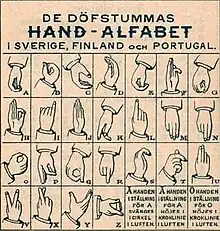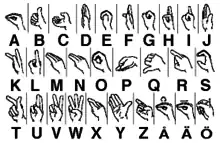Swedish Sign Language
Swedish Sign Language (SSL; Svenskt teckenspråk) is the sign language used in Sweden. It is recognized by the Swedish government as the country's official sign language, and hearing parents of deaf individuals are entitled to access state-sponsored classes that facilitate their learning of SSL.[3] Swedish sign language is strongly linked to the culture of Sweden. There are around 13.000 native speakers and a total of 30.000 speakers.
| Swedish Sign Language | |
|---|---|
| Svenskt Teckenspråk | |
| Native to | Sweden |
Native speakers | 13.000 (2023)[1] |
Swedish Sign
| |
| SignWriting[2] | |
| Language codes | |
| ISO 639-3 | swl |
| Glottolog | swed1236 |
| ELP | Swedish Sign Language |
| Coordinates: 59.3500°N 18.0667°E, 64.0000°N 26.0000°E | |
History
Swedish sign language first came into use in 1800. It does not stem from any other languages. In fact, this self-created language went on to influence Finnish Sign Language and Portuguese Sign Language. 1809 marks the year of the first deaf school, Manillaskolan, in Sweden. It was not until 1981 that Swedish Sign Language was recognized as a national language of Sweden.
| Swedish Sign Language family tree | ||||||||||||||||||||||||||||||||||||||||||||||||||||||||||||||||||||||||||||||||||||||||||||||||||||||||||||||||||||||||||||||||||||||||||||||||||||||||||||||||||
|---|---|---|---|---|---|---|---|---|---|---|---|---|---|---|---|---|---|---|---|---|---|---|---|---|---|---|---|---|---|---|---|---|---|---|---|---|---|---|---|---|---|---|---|---|---|---|---|---|---|---|---|---|---|---|---|---|---|---|---|---|---|---|---|---|---|---|---|---|---|---|---|---|---|---|---|---|---|---|---|---|---|---|---|---|---|---|---|---|---|---|---|---|---|---|---|---|---|---|---|---|---|---|---|---|---|---|---|---|---|---|---|---|---|---|---|---|---|---|---|---|---|---|---|---|---|---|---|---|---|---|---|---|---|---|---|---|---|---|---|---|---|---|---|---|---|---|---|---|---|---|---|---|---|---|---|---|---|---|---|---|---|---|
| ||||||||||||||||||||||||||||||||||||||||||||||||||||||||||||||||||||||||||||||||||||||||||||||||||||||||||||||||||||||||||||||||||||||||||||||||||||||||||||||||||
Hand alphabet
Pär Aron Borg is credited with creating the original hand alphabet in Swedish Sign Language. This handshape system served as a foundational reference for fingerspelling in Swedish Sign Language.
The hand alphabet in Swedish Sign Language has developed since Pär Aron Borg's original creation.
 Pär Aron Borg's hand alphabet |
 Swedish sign language alphabet |
Education and communication
Per the Education Act of 1998, deaf children are expected to be able to write in Swedish and English, in addition to expressing their thoughts in Swedish Sign Language. Thus, six state-run schools (one of which specializes in learning disabilities) have been established regionally for deaf children who cannot attend traditional comprehensive schools. Comprehensive and secondary schools in Sweden offer classes in addition to a one-year program to students to learn Swedish Sign Language as a third national language, as well as in hopes of becoming an interpreter. Interpreters are found in hospitals, and they also teach the language to the parents and siblings of deaf children. Sweden provides 240 hours of courses over four years to parents so that they may learn to communicate with their children. Additionally, weekly courses in the language are also available to the siblings of deaf children and the children of deaf parents.[4]
Expanding the culture of the deaf
Since the recognition of Swedish Sign Language as a national language of Sweden, the Swedish government has made available to deaf individuals television shows and news broadcasts in sign language. Subtitles in sign language are also increasing. On November 29, 2001, the first Bible was translated into Swedish Sign Language. Furthermore, the Health and Medical Service Act (1982) guaranteed interpreters for deaf and hard-of-hearing individuals in working life, leisure, and club activities.[4]
See also
References
- Swedish Sign Language at Ethnologue (25th ed., 2022)

- SignPuddle 2.0. Signbank.org. Retrieved on 2013-10-29.
- Haualand, Hilde; Holmström, Ingela (21 March 2019). "When language recognition and language shaming go hand in hand – sign language ideologies in Sweden and Norway". Deafness & Education International. 21 (2–3): 107. doi:10.1080/14643154.2018.1562636.
- Timmermans, N., & C. (n.d.) (May 1, 2016). The Status of Sign Languages in Europe (PDF). ISBN 978-92-871-5723-2. Archived from the original (PDF) on March 3, 2016.
{{cite book}}:|website=ignored (help)CS1 maint: multiple names: authors list (link)
Further reading
- Lyxell, Tommy. Se språket – barns tillgång till svenskt teckenspråk [See the language – children's access to Swedish Sign Language] (PDF) (Report). Rapporter från Språkrådet (in Swedish). Graphic design by Nyberg, Mikael. Cover image by Nyberg, Tora. Investigated by Spetz, Jennie. Swedish Language Council. ISBN 978-91-86959-14-2.